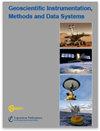代达罗斯电离层剖面延续(DIPCont):蒙特卡罗研究评估现场测量外推的质量
IF 2.3
4区 地球科学
Q3 GEOSCIENCES, MULTIDISCIPLINARY
Geoscientific Instrumentation Methods and Data Systems
Pub Date : 2023-12-01
DOI:10.5194/gi-12-239-2023
引用次数: 0
摘要
摘要。最近代达罗斯号向欧空局提出的任务建议中所预期的对低层热层-电离层系统(LTI)的原位卫星探测对于促进对地球大气和空间环境之间界面的理解至关重要。为了解决近地点以下的物理过程,将使用LTI模型外推原位测量。由于需要评估诸如近地点和远地点距离以及航天器数量等成本关键任务要素如何影响LTI中科学推断的准确性,代达罗斯电离层剖面延续(DIPCont)项目关注不同任务参数和配置下可实现的原位测量外推质量。本报告介绍了DIPCont方法的方法框架。一旦选择了LTI模型,模型参数的集合将通过蒙特卡罗模拟创建,该模拟使用基于模型预测和代达罗斯评估报告中规定的相对不确定性的综合测量。参数的集合会引起对感兴趣的LTI变量的模型高度剖面的集合。外推质量是由高度剖面集合的统计量来量化的。有意义的剖面延拓的垂直范围由外推视界的概念捕获,外推视界定义为偏差保持在规定误差阈值以下的区域边界。为了演示该方法,本文中提出的DIPCont包的初始版本包含一个具有少量参数的简化LTI模型。作为变率的主要来源,温度在LTI上的显著变化被自一致的非等温中性密度和电子密度剖面捕捉到,这些分布是由尺度高度剖面构建的,尺度高度剖面随高度线性增加。本文给出了在不同航天器间距离上的双卫星测量结果的外推视界,也给出了单卫星情况下的外推视界,以比较所考虑的两种基本任务情景。DIPCont模型和过程在一组Python模块和Jupyter笔记本中实现,以补充本报告。本文章由计算机程序翻译,如有差异,请以英文原文为准。
Daedalus Ionospheric Profile Continuation (DIPCont): Monte Carlo studies assessing the quality of in situ measurement extrapolation
Abstract. In situ satellite exploration of the lower thermosphere–ionosphere system (LTI) as anticipated in the recent Daedalus mission proposal to ESA will be essential to advance the understanding of the interface between the Earth's atmosphere and its space environment. To address physical processes also below perigee, in situ measurements are to be extrapolated using models of the LTI. Motivated by the need for assessing how cost-critical mission elements such as perigee and apogee distances as well as the number of spacecraft affect the accuracy of scientific inference in the LTI, the Daedalus Ionospheric Profile Continuation (DIPCont) project is concerned with the attainable quality of in situ measurement extrapolation for different mission parameters and configurations. This report introduces the methodological framework of the DIPCont approach. Once an LTI model is chosen, ensembles of model parameters are created by means of Monte Carlo simulations using synthetic measurements based on model predictions and relative uncertainties as specified in the Daedalus Report for Assessment. The parameter ensembles give rise to ensembles of model altitude profiles for LTI variables of interest. Extrapolation quality is quantified by statistics derived from the altitude profile ensembles. The vertical extent of meaningful profile continuation is captured by the concept of extrapolation horizons defined as the boundaries of regions where the deviations remain below a prescribed error threshold. To demonstrate the methodology, the initial version of the DIPCont package presented in this paper contains a simplified LTI model with a small number of parameters. As a major source of variability, the pronounced change in temperature across the LTI is captured by self-consistent non-isothermal neutral-density and electron density profiles, constructed from scale height profiles that increase linearly with altitude. The resulting extrapolation horizons are presented for dual-satellite measurements at different inter-spacecraft distances but also for the single-satellite case to compare the two basic mission scenarios under consideration. DIPCont models and procedures are implemented in a collection of Python modules and Jupyter notebooks supplementing this report.
求助全文
通过发布文献求助,成功后即可免费获取论文全文。
去求助
来源期刊

Geoscientific Instrumentation Methods and Data Systems
GEOSCIENCES, MULTIDISCIPLINARYMETEOROLOGY-METEOROLOGY & ATMOSPHERIC SCIENCES
CiteScore
3.70
自引率
0.00%
发文量
23
审稿时长
37 weeks
期刊介绍:
Geoscientific Instrumentation, Methods and Data Systems (GI) is an open-access interdisciplinary electronic journal for swift publication of original articles and short communications in the area of geoscientific instruments. It covers three main areas: (i) atmospheric and geospace sciences, (ii) earth science, and (iii) ocean science. A unique feature of the journal is the emphasis on synergy between science and technology that facilitates advances in GI. These advances include but are not limited to the following:
concepts, design, and description of instrumentation and data systems;
retrieval techniques of scientific products from measurements;
calibration and data quality assessment;
uncertainty in measurements;
newly developed and planned research platforms and community instrumentation capabilities;
major national and international field campaigns and observational research programs;
new observational strategies to address societal needs in areas such as monitoring climate change and preventing natural disasters;
networking of instruments for enhancing high temporal and spatial resolution of observations.
GI has an innovative two-stage publication process involving the scientific discussion forum Geoscientific Instrumentation, Methods and Data Systems Discussions (GID), which has been designed to do the following:
foster scientific discussion;
maximize the effectiveness and transparency of scientific quality assurance;
enable rapid publication;
make scientific publications freely accessible.
 求助内容:
求助内容: 应助结果提醒方式:
应助结果提醒方式:


